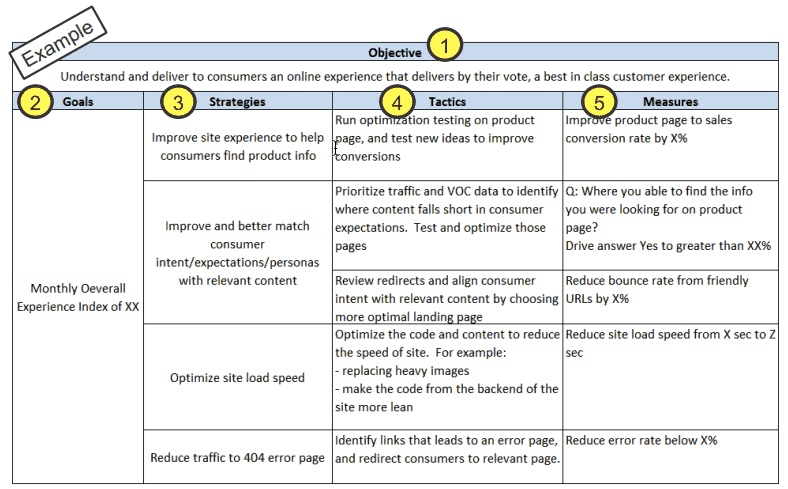
Basics Website KPI Examples and Definitions
An important part of a marketer’s planning job is setting the website KPIs as more businesses are investing more money online. Here are basic website KPI examples and definitions.
An important concept that people would have to understand is the differences in the common metrics and KPIs used in the site analytics industry. Following KPIs are examples defined in the web analytics association’s document.
These basic terminologies would be the best starting point to understand and generate KPIs that are actionable to your website business strategies.
KPIs should be differentiated from any operational measures that allow you to assess if your marketing efforts are influencing your KPIs. Here is a framework that shows how KPIs are different from metrics.

KPI Definition Framework
- Count: Basic unit of measure, not a ratio. Ex) Visits, Page Views, Total Sales
- Ratio: Typically, a count is divided by a count. Ex) Page Views per Visit
- KPI (Key Performance Indicator): KPI can be a count or ratio; it is infused with business strategy. The set of appropriate KPIs typically differs between a website and process types.
- Dimension: A general source of data that can define various types of segments or counts and represents a fundamental dimension of visitor behavior or site dynamics.
Metrics are applicable to three different data universes: Aggregate, Segmented, Individual
Building Block Terms
Page:
Type – Dimension
Universe – Aggregate, Segmented, Individual
A page is an analyst-definable unit of content.
Page Views
Type – Count
Universe – Aggregate, Segmented
The number of times a page was viewed.
Visits (Sessions)
Type – Count
Universe: Aggregate, Segmented
A visit is an interaction, by an individual, with a website consisting of one or more requests for an analyst-definable unit of content. The visit session will terminate if an individual has not taken another action on the site within a specified period (typically, 25 to 30 min).
Unique Visitors (New Visitor, Repeat Visitor, Return Visitor)
Type – Count
Universe – Aggregate, Segmented
The number of inferred individual people within a designated reporting timeframe, with activity consisting of one or more visits to a site. Each individual is counted only once in the unique visitor measure for the reporting period.
Visit Characterization
Entry Page: Type – Dimension
Landing Page: Type – Dimension
Exit Page: Type – Dimension
Visit Duration: Type – Count
Referrer (Internal, External, Search, Visit, Original): Type – Dimension
Click-through: Type – Count
Click-through Rate: Type – Ratio
Page Views per Visit: Type – Ratio
Content Characterization
Page Exit Ratio: Type – Ratio
Single Page Visits: Type – Count
Single Page View Visits (Bounces): Type – Count
Bounce Rate: Type – Ratio
Conversion Metrics
Event: Type – Dimension
Conversion: Type – Dimension
Ok, so now you have a general sense of what could be the building block of your KPIs, you’re probably wondering what should define your list of KPIs.
First, you’ll need to know what your website’s objectives are. Typically that will be very few critical things.
Avinash, a well-known web analytics evangelist, says three specific desired Outcomes from a website are:
- Increased Revenue
- Reduced Costs
- Improved Customer Satisfaction and Loyalty
Now stepping aback a little bit, on a higher level, the three main Objectives for making a website are:
- Acquire
- Convert
- Retained
Ok, so if you check out this framework, you can start building your list according to the Goal you’d like to set, which will be your KPI. Not the operational measures that track the strategies and tactics.
If you run an e-commerce website that sells something from your site, I suggest making the KPIs the following:
- Unique visitors
- Conversion rate
- # of orders
- Average order value
- Revenue

Now, you need to understand what KPIs to choose that will help you measure the success of your website. For more details on understanding the Matrix to Set Your Website Objectives and Outcomes, click here.
Thank you so much for taking the time to read my content. If you've liked what I've had to say please subscribe!
ZoomMetrix Newsletter
Join the newsletter to receive the latest updates in your inbox.